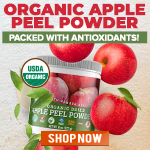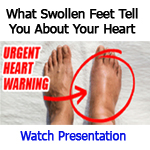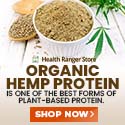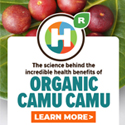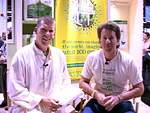
CEO of Seventh Generation explains the benefits of natural cleaning products to health and home
 Monday, July 31, 2006 Monday, July 31, 2006by Mike Adams, the Health Ranger Editor of NaturalNews.com (See all articles...) Tags: green home products, children's health, toxic chemicals |
- Hidden poison in your medicine and supplements: How phthalates in capsules are silently attacking your heart, thyroid, and hormones
- EU court exposes secret Pfizer deal, orders von der Leyen and Bourla to reveal concealed texts
- When the storm brings spies: How a top weather app became an agent of surveillance
- Hidden betrayal: Moderna and Pfizer shots hijack immune cells to rewrite mRNA, prolonging spike protein production
- Renegade cardiologist joins MAHA, demands immediate halt to mRNA vaccines and overhaul of US health policies
- OUTRAGE: Georgia shields pesticide giants from cancer lawsuits as corporate lobbying silences victims
- Lard: A highly nutritious but misunderstood superfood
- Judge rules Kansas vaccine lawsuit against Pfizer must proceed in state court
- Health Ranger Report: Dr. Alphonzo Monzo discusses nanotechnology, 5G and the weaponization of health
- CLIMATE PONZI SCHEME DENIED: Trump begins the exit of the BIGGEST WASTE of money, resources and human lives ever and the climate alarmists are freaking out
- The great awakening: How people are questioning power structures and embracing truth
- The mouth-brain connection: Could dental health guard against dementia (and vice versa)?
- Breakthrough study reveals how Epstein-Barr and a gene variant heighten multiple sclerosis risk
- Kraft Heinz pours $3 billion into U.S. factories as Trump tariffs reshape manufacturing
- Coinbase faces $400M fallout after insider-led phishing attack exposes customer data
- Thwarted ISIS plot on Michigan military base highlights ongoing domestic terror threat
- Pfizer’s election meddling exposed: Top scientists weaponized science to sway the 2020 vote, so they could benefit from unlawful mandates
- Rudolf Breuss introduces a natural approach to treating cancer and chronic illness in “The Breuss Cancer Cure”
- WAR ON COGNITION: The Coordinated Assault on Your Brain and How to Defend Yourself Against Every Attack
- Singapore's draconian vaccine mandate: Citizens face jail time for refusing FORCED medical procedures that do HARM
- Big Pharma's Dirty Secret: How Prescription Drugs Are Starving Your Body of Essential Nutrients
- Canada's COVID cover-up: Health officials swore secrecy to protect Trudeau from vaccine scandal
- RED ALERT: Nuclear War Between India and Pakistan Could Trigger Global Catastrophe… full RISK ANALYSIS
- JESUS NEVER SPOKE ENGLISH: Historical facts on why the Bible you’re probably reading has been altered, redacted or hidden from much of its original meaning
- Gene-edited pork sneaks onto your plate: FDA quietly approves CRISPR pigs amid health and ethical concerns
- Silent catastrophe: COVID-19 vaccines linked to plummeting fertility rates, Czech data reveals
- Why All Government Officials and Big Tech CEOs Who Engage in Systematic Viewpoint Censorship Must Be ARRESTED, Prosecuted, and Sentenced to Life in Prison
- Brushing with poison: Study finds toxic heavy metals in 90% of toothpaste brands, including those for children
- Survival basics: 5 Dangerous locations to avoid during an EMP attack
- BBC accused of “political censorship” for shelving Gaza documentary amid mounting pressure
- EU embraces censorship over solutions as energy grid crises spark blackout fears
- Health Ranger Report: Christopher Bjerknes challenges conventional narratives about world history
- Australia’s vaccine cover-up: 35 died same day as COVID shot, but authorities ignored them
- Landmark study of 85 million reveals shocking surge in heart attacks, strokes, and sudden death following the notorious COVID-19 jab
- Hidden poison in your medicine and supplements: How phthalates in capsules are silently attacking your heart, thyroid, and hormones
- The truth about Benzyl Alcohol in beauty products
- The Miraculous Healing Power of DMSO: Nature's Forgotten Cure for Cancer, Pain, and Regeneration
- Biblical truth: God will carry out a “cosmic reset” of Earth and destroy all human civilization with a series of extinction-level cosmic impacts known as The Seven Trumpets, Seven Bowls and Seven Seals
- URGENT REPORT: The China Import Embargo - What to Stockpile Now Before America Runs Out
- The Ultimate Survival Guide to Baking Soda: A Miraculous, Multi-Purpose Remedy for Health, Home, and Emergency Preparedness
- Widespread social and economic unrest: Steve Quayle issues urgent financial warning of imminent asset collapse in new interview with Mike Adams
- Aerosolized bioweapons? Strange “diploid biomasses” falling out of the sky in Florida captured under the microscope
- A call to preserve America’s future: “Defeating Big Government Socialism” by Newt Gingrich
- Stunning Visualization of the Seven Trumpets in the Book of Revelation
- Big Pharma launches “Vaccine Integrity Project” to combat Secretary Kennedy and keep 94 shots going into kids with mandates and liability protections
- World Economic Forum's current downfall exposes legacy of totalitarianism, financial fraud, and crimes against humanity
- Biden regime deployed over 600 grants to fund disinformation agenda, to silence the truth and stifle debate
- The Miraculous Healing Power of Green Tea: Unlocking the Potent Antioxidants That Big Pharma Doesn't Want You to Know About
- The unspoken truth about chemotherapy: These “treatments” create toxic time bombs in your body called CELL-KILLING PARTICLES
- U.S. Government's Bio-War Against America: 15 Historical Medical Horrors Inflicted on the American People by the Government Itself
- A win for free speech: State Department SHUTS DOWN controversial disinformation office
- U.S. demands U.K. protect FREE SPEECH, repeal hate speech authoritarianism, in latest trade deal negotiations
- French rioting demonstrates how gun control laws are failing law-abiding citizens
- Head of L.A. Port warns of incoming plunge in U.S. supply chain, empty shelves and inventory depletion in 5-7 weeks
- Red Cross issues warning to stop blood plasma donations from vaccinated people
- Scientists confirm: GENIUS brain function can be spontaneously unleashed in humans without any apparent cause
- EPA advisor admits the agency is funneling billions to climate groups ahead of Trump’s return to White House
- HYSSOP: What research reveals about the health benefits of this ancient holy herb
- Two containers with completed ballots fall out of truck in Florida
- Newly released JFK files reveal Pentagon's role in creating Lyme disease and covid in the same lab
- Mike Adams releases country western hit single: Goin’ Back in Time is Comin’ Home
- Global leaders unite to clamp down on “misinformation” with UN-backed Cascais Declaration
- BREAKING: 2025 NDAA authorizes mandatory military draft of WOMEN across America… as Pentagon pursues global NUCLEAR war with both Russia and China at the same time
- I Want My Bailout Money – new song released by Mike Adams
- Michael Yon warns of a ZIONIST TAKEOVER in Trump’s second administration
- Ozempic and Wegovy weight loss drugs are injectable LIZARD VENOM PEPTIDES that may unleash a devastating wave of organ failure… side effects align with symptoms of SNAKE BITES
- The Health Ranger releases “Vaccine Zombie” song and music video, using AI-animated zombies for the music video
- BOMBSHELL: DNA testing kits are a SCAM to develop ethnic-specific bioweapons
- These 13 countries just signed an agreement to engineer a global FAMINE by destroying food supply
- Israeli soldiers accused of even more torture and abuse in the West Bank
- RFK Jr. clears key hurdle: Sen. Susan Collins backs controversial HHS nominee, signaling a new era for health policy
- Sermon 30: How Jesus reveals Caesar’s FAKE CURRENCY and FALSE AUTHORITY
Jeffrey Hollender: Well, we are creating all the products you need to have a healthy home, and we've recently expanded into the personal care category with natural diapers, as well as feminine care products, including tampons that are made of certified organic cotton.
Mike: I'm glad to see that your company is expanding, but the core product line that you're best known for are for dishwashing and laundry uses, correct?
Hollender: That's right. These include household cleaning products such as dishwashing products, laundry products and all types of spray cleaners. That is really where we got started, because it is largely through those household cleaning products that people pollute the air in their homes. According to the EPA, the air in our homes is two to five times more polluted than the air outside of our homes.
Mike: Wow.
Hollender: Our homes are so largely polluted that the California Air Resources Board evaluated the second greatest source of air pollution after automobiles in the state of California, and it was household cleaning and personal care products, including paints and stains. One product, Tilex, emits eight tons of volatile organic compounds (VOCs) into the air in our homes every day in the state of California.
Mike: That's an amazing statistic.
Hollender: Those VOCs, we know, can trigger asthma attacks in children, and it's no surprise that asthma rates for children under 18 are up 100 percent over the past 10 years.
Mike: Yes. Now, I'm one of your best customers, by the way. You may not have known that, but that's why I really wanted to interview you. I'm so glad that your company exists and that your products exist, because it's not only as you mentioned -- the volatile organic chemicals released by products in the household -- it's also what happens downstream with all these products, right?
Hollender: Absolutely, that is correct.
Mike: So, with your products, we get to protect our own health and that of our families, but also the health of rivers and streams and oceans.
Hollender: It's absolutely true, and when we think about our products, we think about the system that they're a part of. If they're bad for your health, they're probably bad for the environment. If they're bad for the environment, they're probably bad for your health. And we try to understand the system -- which includes nature, the home environment, our health, all of those pieces -- to try to design products that work well in all parts of the system they interact with, which includes going upstream. What was the plant doing that made them? Where did the raw materials come from? One of the reasons that we're so focused on cleaning products made with vegetables instead of petroleum is that people don't think that when they clean their homes with natural cleaners like Seventh Generation, they're actually helping to reduce our dependence upon petroleum.
Mike: It's a very good point. We really have to think about all the factors that come into play with these products. One of the main questions I'm often asked about the Seventh Generation product line is, "How do they make them so effective if the ingredients aren't these harsh chemicals?"
Hollender: The truth is that nature is often far more effective than many of the synthetic things that we have manufactured. There is a wonderful book by a woman name Janine Benyus called "Biomimicry," and it talks about how nature has created amazing things that are applicable to the products we use. It is really a misnomer to think that, because it's natural, it won't work as well. Sometimes it actually works better. But, we test all of our products against leading brands to ensure that they work as well because we know -- as much as we'd like people to do the right thing -- if the products don't work, they won't come back and buy them.
Mike: Very true. I wonder if you have many customers who share this experience that's common to myself and some of our readers. There's that aisle in every store -- that cleaning and detergent aisle that I can't even stand to walk down because the chemicals are so toxic. You smell them 50 feet away. Your products are clean and you can tell it from interaction with the products. I can't even get near those other brand-name products anymore. Is that a common thing you hear?
Hollender: Yes. As a matter of fact, the New York Times, two years ago, had a full-page picture of a woman walking down the detergent aisle of a supermarket with a gasmask on. It was the only way she could go into the store and shop.
Mike: Oh, wow.
Hollender: Because the -- among other things -- fragrances in those detergents are so potent that many people can't shop in the store.
Mike: Right.
Hollender: There is a tremendous sensitivity to fragrances. We sell a lot of products that are free and clear and have no fragrances or dyes in them, but we do sell some products that have fragrances. We try to use natural, and, where possible, organic fragrances. But fragrances will trigger allergy attacks in some people even if they're organic.
Mike: Yes.
Hollender: So, we need to provide those safe solutions for people who can't tolerate any fragrances at all.
Mike: I'm so glad you do. That's -- again -- one reason I'm one of your best customers. Now, let's talk about a new project that you have coming up that is covered in this book, "Naturally Clean."
Hollender: Sure.
Mike: This is due to come out when?
Hollender: Actually, it's coming out right this week. I've just seen copies for the first time yesterday. We created this book, which I actually wrote with my daughter, Meika -- who is 18 years old -- to help people go through their house, room by room, to know the most important things they can do to keep their home healthy.
Mike: Outstanding.
Hollender: We are giving 100 percent of the profits from the book to the Children's Environmental Health Coalition, CHEC, that is launching something called the Blue Butterfly Campaign to help people keep their homes safe -- particularly for children.
Mike: Now is this a public education program?
Hollender: Yes. It's a public education campaign that CHEC is launching in May, and the Blue Butterfly Campaign will focus on five tips that are the most important things you could do in your home. They'll have a number of celebrity spokespeople talking about this, and it's a privilege for us to be able to participate in this program with them because it is completely focused on education.
Mike: Now, let's remind everyone why it is important to focus on clean homes, especially with children.
Hollender: Children are so much more susceptible to these toxins. In many cases, their system has not completed development and the adverse harm that a child could experience with some of these toxins is, in order of magnitude, much greater than adults. So, they're crawling around on the floor and they're putting things in their mouths. One of the things that amazes me is this whole issue of disinfectants. Most people don't know that disinfectants are pesticides. They are regulated by the same rules, and many moms and dads want to feed their kids organic foods because they don't want their children consuming pesticides. Yet, they'll run around the house spraying disinfectants, which are pesticides, in the air, so children breathe the disinfectants, wipe them off the counter and put them in their mouth.
Mike: Right.
Hollender: In most cases, soap and water will do just as good a job removing those germs. By the way, some of those germs are good for our children. We need to be particularly concerned about children. We need to be particularly concerned on making sure that we're creating a safe environment for them.
Mike: Now, I'm going to play devil's advocate with you here for a second, Jeffrey.
Hollender: Good.
Mike: Because it is the position, I believe, of your conventional competitors -- you know, the big brand-name companies -- that these chemicals are perfectly safe, that they aren't absorbed through the skin, that they don't affect children in any way and that they have no harm to the environment. What's your answer to that kind of reasoning?
Hollender: They make a little more subtle argument. Basically, what they'll say is that there's no dispute that some of these chemicals will cause developmental disorders, reproductive disorders or that they're carcinogenic. These are the chemicals we can't debate because there's enough science that shows that the chemicals in these traditional products -- including products like baby wipes and laundry detergent -- have highly toxic chemicals in them. The debate is based on, "well, there's such a small amount of these bad chemicals, like chlorine, in the product that there is no proof that it's dangerous." It is very hard to prove that one chemical amongst 50 in a product -- when you're exposed thousands of products -- that that one chemical is to blame.
Our message is very simple -- why take a chance? If you can buy organic and if you can buy natural household cleaning products that don't have those chemicals in them, then do it. We know that dioxin, for example, which is something that's created when paper is bleached with chlorine, is the most dangerous carcinogenic chemical on the face of the earth. It is 300 times more toxic than Agent Orange. Now, why would you want to bring products that have even the smallest amount of dioxin residue into your home? It just doesn't make sense to me.
Mike: Right.
Hollender: What we know about things like cancer is there usually is no one chemical exposure that causes cancer. It's the multiplying effect of maybe 10 different exposures to different types of toxins. What we're saying is to reduce that exposure where you can. Be safe. We can't afford to take these kinds of chances, especially with our children.
Mike: So your product line then -- and some of the traits that the products have -- is that the papers, for example, are unbleached?
Hollender: Or non-chlorine bleached. One or the other. If they're beige or brown, they are unbleached.
Mike: Very good.
Hollender: If they're white, we have used oxygen or hydrogen peroxide to get those paper products white, which are non-reactive and don't create any of the organo-fluorides and organo-toxins that bleaching paper with chlorine does.
Mike: So, what are some of the other traits of your products, then?
Hollender: Wherever possible, we're using vegetable as opposed to petroleum ingredients. We will only use ingredients that are known to be safe, so we need thorough affirmative proof that the chemical is not even suspected of having any health or environmental problems. Specific products like our auto dish detergent don't have phosphates or chlorine. Generally, none of the products we make have any chlorine in them. Chlorine is probably the greatest concern to us and we know from an industrial perspective how dangerous it is. There is increasing concern about all these railcars driving around the country filled with chlorine because sometimes, when they have an accident, whole towns have to be evacuated. So why do you want to bring that into your home?
Mike: Exactly.
Hollender: Why do you want to be using that chemical to whiten your laundry when it could be done just as well with hydrogen peroxide or non-chlorine bleach? Ammonia is another chemical -- I mean generally any chemical that is a VOC, or volatile organic compound -- is a chemical that we don't want to use. Pretty much the only exception we make are natural fragrances that have a small amount of VOC in them, but we won't use any other chemicals other than that. When you smell chlorine, what you smell is, in part, those VOCs. When you smell ammonia, VOCs are what you smell, and what is really scary is the way these chemicals react with each other. Every year, believe it or not, 60,000 people end up having an accident with chlorine in their homes. Three people a year, on average, die -- and thousands have serious injuries. If you get chlorine or sodium hypochlorite in your eye -- that's what's in chlorine bleach -- after four seconds of it being in your eye, it is likely to cause damage that's non-repairable. Four seconds. Now, if you get it in your eye, I don't know if you can even get to the sink that fast and turn the water on quick enough.
Mike: Right.
Hollender: So, we're saying, with children at home, why would you want a product that is that dangerous in your household? There was a story recently about a woman in Japan who got hypochlorite in her eye and went blind. Sixty thousand people a year are having an accident with these chemicals, and that tells me that there's really something that we want to do to prevent that.
Mike: Or, why would you want to soak your clothes in these chemicals and then put these clothes on your skin, too?
Hollender: You're exposing your skin and -- quite frankly -- it's such a strong chemical that it is degrading the fibers of your clothes.
Mike: That's right.
Hollender: Your clothes will probably last longer if you don't expose them to chlorine bleach because it is such a harsh, reactive chemical.
Mike: Your products are well-represented in the marketplace. They're available in just about every health food store I've ever walked into.
Hollender: Right.
Mike: Online, Gaiam carries the product line.
Hollender: Yes.
Mike: Where else can people find your products?
Hollender: Well, in addition to natural food stores and Gaiam, they can actually find them on websites like Amazon and Drugstore.com , as well as a number of traditional grocery stores. Many of the Kroger stores and Safeway stores will have a more limited selection of our products. You're going to get the biggest selection in a store like Whole Foods or Wild Oats, but I think 70 percent of all the Safeway stores in the United States have some Seventh Generation products available.
Mike: I'm surprised. That's good to hear.
Hollender: Even Target carries our products. We just did a test in 50 Target stores, which is going to be expanded this summer.
Mike: Fantastic. Here's one last question. The name Seventh Generation; where does that come from?
Hollender: When we started the company, we had a young woman who was part Mohawk working for us, and we were having a contest to figure out what to name the company. She had the idea to call the company Seventh Generation using the Iroquois tradition, because the name Seventh Generation comes almost out of what you would consider their Bible. The phrase is, "In our every deliberation, we should consider the impact of our decisions on the next seven generations." That name is an aspiration that we strive to live up to. It guides us in everything we do and it is almost, in some respects, our moral compass. If it's not the right thing to do for the next seven generations, it's probably not something we should do. Living in the world that we do -- where we're surrounded with people making very short-term decisions -- it's quite a challenge to live up to.
Mike: Indeed, it is, but you are doing a fantastic job of following that moral compass. Thank you, Jeffrey, for your time today and for doing what you do in the marketplace. I think you're making a tremendous difference and for those reading, the product line is Seventh Generation. For those reading, Seventh Generaton is for your green home, your clean home and for affecting your children, your children's children and on down the line. You just heard the story behind the name. We've been talking to Jeffrey Hollender, here to give us the full explanation. Thank you very much, Jeffrey.
Hollender: It's my privilege. Thank you.
Green home products at FETCH.news
Get independent news alerts on natural cures, food lab tests, cannabis medicine, science, robotics, drones, privacy and more.
 About the author:Mike Adams (aka the "Health Ranger") is a best selling author (#1 best selling science book on Amazon.com) and a globally recognized scientific researcher in clean foods. He serves as the founding editor of NaturalNews.com and the lab science director of an internationally accredited (ISO 17025) analytical laboratory known as CWC Labs. There, he was awarded a Certificate of Excellence for achieving extremely high accuracy in the analysis of toxic elements in unknown water samples using ICP-MS instrumentation. Adams is also highly proficient in running liquid chromatography, ion chromatography and mass spectrometry time-of-flight analytical instrumentation.
About the author:Mike Adams (aka the "Health Ranger") is a best selling author (#1 best selling science book on Amazon.com) and a globally recognized scientific researcher in clean foods. He serves as the founding editor of NaturalNews.com and the lab science director of an internationally accredited (ISO 17025) analytical laboratory known as CWC Labs. There, he was awarded a Certificate of Excellence for achieving extremely high accuracy in the analysis of toxic elements in unknown water samples using ICP-MS instrumentation. Adams is also highly proficient in running liquid chromatography, ion chromatography and mass spectrometry time-of-flight analytical instrumentation.
Adams is a person of color whose ancestors include Africans and Native American Indians. He's also of Native American heritage, which he credits as inspiring his "Health Ranger" passion for protecting life and nature against the destruction caused by chemicals, heavy metals and other forms of pollution.
Adams is the founder and publisher of the open source science journal Natural Science Journal, the author of numerous peer-reviewed science papers published by the journal, and the author of the world's first book that published ICP-MS heavy metals analysis results for foods, dietary supplements, pet food, spices and fast food. The book is entitled Food Forensics and is published by BenBella Books.
In his laboratory research, Adams has made numerous food safety breakthroughs such as revealing rice protein products imported from Asia to be contaminated with toxic heavy metals like lead, cadmium and tungsten. Adams was the first food science researcher to document high levels of tungsten in superfoods. He also discovered over 11 ppm lead in imported mangosteen powder, and led an industry-wide voluntary agreement to limit heavy metals in rice protein products.
In addition to his lab work, Adams is also the (non-paid) executive director of the non-profit Consumer Wellness Center (CWC), an organization that redirects 100% of its donations receipts to grant programs that teach children and women how to grow their own food or vastly improve their nutrition. Through the non-profit CWC, Adams also launched Nutrition Rescue, a program that donates essential vitamins to people in need. Click here to see some of the CWC success stories.
With a background in science and software technology, Adams is the original founder of the email newsletter technology company known as Arial Software. Using his technical experience combined with his love for natural health, Adams developed and deployed the content management system currently driving NaturalNews.com. He also engineered the high-level statistical algorithms that power SCIENCE.naturalnews.com, a massive research resource featuring over 10 million scientific studies.
Adams is well known for his incredibly popular consumer activism video blowing the lid on fake blueberries used throughout the food supply. He has also exposed "strange fibers" found in Chicken McNuggets, fake academic credentials of so-called health "gurus," dangerous "detox" products imported as battery acid and sold for oral consumption, fake acai berry scams, the California raw milk raids, the vaccine research fraud revealed by industry whistleblowers and many other topics.
Adams has also helped defend the rights of home gardeners and protect the medical freedom rights of parents. Adams is widely recognized to have made a remarkable global impact on issues like GMOs, vaccines, nutrition therapies, human consciousness.
In addition to his activism, Adams is an accomplished musician who has released over a dozen popular songs covering a variety of activism topics.
Click here to read a more detailed bio on Mike Adams, the Health Ranger, at HealthRanger.com.
Take Action: Support Natural News by linking to this article from your website
Permalink to this article:
Embed article link: (copy HTML code below):
Reprinting this article:
Non-commercial use OK, cite NaturalNews.com with clickable link.
Follow Natural News on Facebook, Twitter, Google Plus, and Pinterest
Science News & Studies
Medicine News and Information
Food News & Studies
Health News & Studies
Herbs News & Information
Pollution News & Studies
Cancer News & Studies
Climate News & Studies
Survival News & Information
Gear News & Information
News covering technology, stocks, hackers, and more



"Big Tech and mainstream media are constantly trying to silence the independent voices that dare to bring you the truth about toxic food ingredients, dangerous medications and the failed, fraudulent science of the profit-driven medical establishment.
Email is one of the best ways to make sure you stay informed, without the censorship of the tech giants (Google, Apple, Facebook, Twitter, YouTube, etc.). Stay informed and you'll even likely learn information that may help save your own life."
–The Health Ranger, Mike Adams













